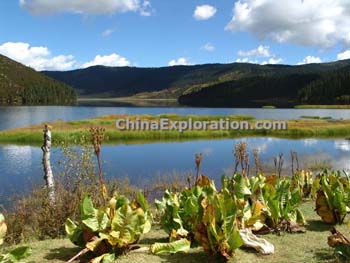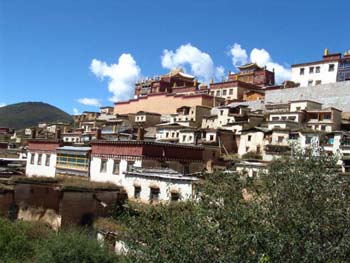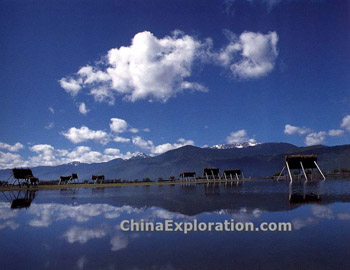search for a Trip
Introduction of Shangri-la
Shangri-la, also called Zhongdian originally is located between the boarder of Yunnan province and Sichuan province It becomes worlds famous, for British writer James Hilton depicted in his novel "Lost Horizon" that a British diplomat and three of his friends landed in a snow-capped mountain area during a flight from China to India due to lack gasoline, they were rescued by local Tibetan and spent some time in a very beautiful place. Later, they came back to seek for the plane but failed. The only thing they remembered was the Tibetan word "Shangri-la". Now much evidence has proved that "Shangri-la" is right here in zhongdian. In the land of Shangri-la, they have diverse recourses of Tibetan culture and plateaus, such as the famous monastery of Songtanlin , Mt Meili snow mountain, three Parallel Rivers. Shangri-la is a paradise for peaceful soul.

Main attractions in Shangri-la
Baimang Snow Mountain
Located in Deqin County of Yunnan Province, the eastern part of the northern section of the Yunling Mountains, between the Jinsha River and Lancang River, the snow mountain covers a total area of 187,977 hectares. Most of the peaks are 5,000 meters high, with the highest one-Mount Zhalaqueni-standing at 5,640 meters above sea level. It is the largest and highest natural reserve area in Yunnan Province.
Pudacuo National Park:
It is the first national park in China, composed by Bita hai lake, Sudu lake and the first village of Shangri-la.
Bita Lake
Situated about 32 kilometers (about 19.9 miles) away from Shangri-La County(zhongdian), covering an area of 166 hectares, Bita Lake, a fault lake, is an intact natural attraction with various species of flora and fauna and picturesque landscapes. In Tibetan language, Bita means "a piece of land as soft as cattle hair felt". With an altitude of 3,539 meters (about 11,608 feet), the lake is the highest in Yunnan Province. The main attraction of this area is the Tibetan folklore, the primeval forest, the highland meadow, and the highland flowers and plants.

Napa Sea
Napa Sea, also called Yila Prairie, is a lake in rain season, while grassland in other season. In the autumn, thousands of sheep, horses and yaks scatters on the grasslands. It just likes a necklace broken on the lawn. It is the habitat of about 150 black neck cranes. The total number of black neck cranes is around 1000 in the whole world.
Haba Snow Mountain
The Haba Snow Mountain is located by the Golden Sand River with an elevation of 5,396 meters for its main peak and the lowest river surface elevation of 1,550 meters above sea level. The nature reserve extends 22 kilometers from south to north and 19 kilometers from east to west. About half of the 13,000 kinds of plants in Yunnan, the Kingdom of Plants, could be found in here.
Songzanlin Monastery
Songzanlin Monastery, or "Little Potala" as it is affectionately known, is a spiritual hub for people to discover the mystery and traditions of Tibetan Buddhism. Located at the foot of Mt. Foping, faces a vast grassland that used to be smothered by a lake, the Songzanlin Monastery is the largest and the most important Lamasery of Tibetan Buddhism in Yunnan province, as well as one of the 13 large lamaseries in the joint area of Tibet, Sichuan and Yunnan. During its time of greatest prosperity, there were more than 3,000 monks in the temple. The architectural style of the building is a faithful imitation of the Potala Palace in Lhasa, Tibet. The main hall in the center of the complex features imposing pillars and murals, which vividly depict the traditions and beliefs of Tibetan Buddhism, such as the "wheel of life" that illustrates the six realms of existence—heaven, demigods, humankind, hell, hungry ghosts and animals. The incense drifting in wisps, the fragrant oil lamps and the number of old monks instructing younger ones, can give one the impression that time has stood still in this little paradise since the creation of the temple.

Jinsha River
The Jinsha River, located in the upper reaches of the Changjiang River, has cut across several rivers which southward flowed into fault basins, and eastward flowed into Sichuan Basin. It does a U-turn at Shigu Town and flows northward, before veering first to the south and then to the east. The Jinsha River roars between the Haba Mountains and the Jade Dragon Mountains, bringing into being the famous Tiger Leaping Gorge.
Mingyong Glacier :
Mingyong Glacier sits at the foot of Kagebo Peak and looks like a long piece of white silk. Running from 5,500 meters down to 2,700 meters, only 800 meters above Lancang River. Mingyong is one of the few low altitude glaciers in the world. There is a 40km ride between Deqin and Mingyong Village, and then you can walk or rent a horse to get to the glacier.
Three Parallel Rivers
In the early 1980s, an expert from the UNESCO World Heritage Centre found a unique phenomenon from a satellite remote sensing image: From east longitude 98 to 10030', north latitude 2530' to 29, an area with a diameter of less than 100 kilometers, three great rivers roar in parallel. This unique spectacle of nature is known as the "Three Parallel Rivers." It covers a region from the southern edge of the Qinghai-Tibet Plateau to the core of the Hengduan Mountains in Yunnan Province, through which flow the Jinsha, Lancang and Nujiang rivers.
Its unique geological appearance, hydrological environment, ecology, and great diversity of biology and regional cultures, began attracting international attention back in the 19th century.
The "Three Parallel Rivers" cover an area of 34,000 square kilometres, including parts of the Diqing Tibetan Autonomous Prefecture, Nujiang Lisu Autonomous Prefecture and the city of Lijiang in Yunnan. The region is rare in terms of the variety of ethnic groups, languages, religions and customs, not only in China, but worldwide. On July 2, 2003, the site was included on the World Heritage List at the 27th session of the UNESCO's World Heritage Committee.
Climate of Shangri-la
|
Month |
Jan |
Feb |
Mar |
Apr |
May |
Jun |
Jul |
Aug |
Sep |
Oct |
Nov |
Dec |
|
Temperature (Celsius) |
-4.6 |
-3.2 |
4.5 |
10.1 |
13.8 |
18.0 |
20.8 |
23.4 |
15.4 |
11.4 |
3.1 |
-1.7 |
Click to see Shangri-la tours
China Attractions Guide
- Anhui Attractions
- Beijing Attractions
- Chongqing Attractions
- Fujian Attractions
- Gansu Attractions
- Guangdong Attractions
- Guangxi Attractions
- Guizhou Attractions
- Hainan Attractions
- Henan Attractions
- Hongkong Attractions
- Hubei Attractions
- Hunan Attractions
- Inner Mongolia Attractions
- Jiangsu Attractions
- Jiangxi Attractions
- Manchuria Attractions
- Ningxia Attractions
- Qinghai Attractions
- Shaanxi Attractions


